Alfonso X el Sabio, 1221-1284. Cantigas de Bizancio
El Oriente Cristiano · The Christian Orient / Eduardo Paniagua
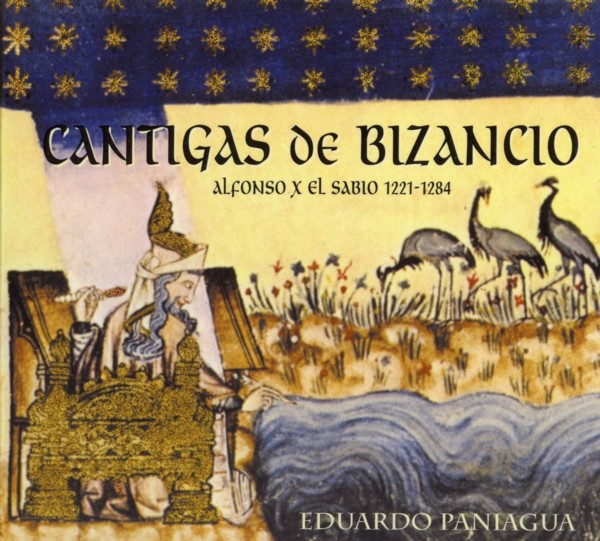
medieval.org
Pneuma «Colección Cantigas» PN2-880
2006
CD 1
Iconos bizantinos e imágenes de
Santa María
Byzantine Icons and Images of the Virgin Mary
1. EL ICONO DE DAMASCO • THE ICON OF DAMASCUS
Por que nos ajamos [13:39]
CSM 9
2. EL ICONO PERDIDO • THE LOST ICON
Gran dereit' é que fill' o demo [7:40]
CSM 34
3. LA VIRGEN DE LA LECHE • THE VIRGIN OF THE MILK
Nas mentes sempre tẽer [4:45]
CSM 29
4. VIRGEN BLACHERNIOTISSA • THE VIRGIN BLACHERNIOTISSA
Pois aos seus que ama [9:39]
CSM 264
5. EL MORO DE ULTRAMAR Y LA VIRGEN DE LA LECHE • THE MOOR FROM OVERSEAS AND THE VIRGIN OF THE MILK
Porque ajan de seer [9:19]
CSM 46
6. EL CERCO DE CONSTANTINOPLA • THE SIEGE OF CONSTANTINOPLE
Todo logar mui ben pode [11:30]
CSM 28
CD 2
Santos, Patriarcas y Emperadores
Saints, Patriarchs and Emperors
1. SAN JUAN ELEIMOSYNARIUS • ST. JOHN ELEEMOSYNARIUS
O que pola Virgen de grado [10:23]
CSM 145
2. SAN JUAN DAMASCENO • ST. JOHN THE DAMASCENE
Sempr' a Virgen Santa [10:54]
CSM 265
3. EL EMPERADOR Y EL PATRIARCA • THE EMPEROR AND THE PATRIARCH
En tamanna coita non pode seer [12:31]
CSM 131
4. EL JUDÍO DE BIZANCIO • THE JEW FROM BYZANTIUM
Pagar ben pod' o que dever [13:49]
CSM 25
5. ICONO EN LA PIEDRA • THE ICON IN THE STONE
Con razon nas creaturas [9:58]
CSM 342
6. SAN JUAN CRISÓSTOMO • ST. JOHN CHRYSOSTOM
Quen a Santa Maria de coraçon [8:10]
CSM 138
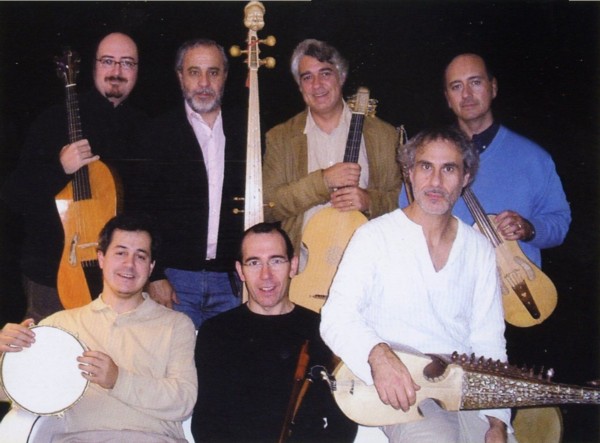
MÚSICA ANTIGUA
Eduardo Paniagua
Cesar Carazo — canto tenor y viola
Luis Antonio Muñoz — canto bajo, fídula y pandero
Luis Calero — canto contratenor
Felipe Sánchez — vihuela de péñola y guitarra medieval
Dimitri Psonis — santur, lira griega, saz y rababa
Jaime Muñoz — kaval, ajabeba, cálamo, chalumeau, gaita y gayda
David Mayoral — darbuka, panderos, panderetas y campanas
Eduardo Paniagua — tromba marina y flautas dulces
Diseño gráfico: Pneuma
Portada: Cantiga 110, Miniatura 6 ·
Interior: Miniaturas del prólogo, y cantigas
n° 9 y 34
Traducción poemas: José Filgueira
English translation: Lesley Ann Shuckburgh
Grabado el 12 de noviembre de 2006 en Axis. Madrid por Hugo Westerdahl
Producción: EDUARDO PANIAGUA • 2006 PNEUMA
Depósito Legal: M-38700-2006
Dirección General de Promoción Cultural
CONSEJERÍA DE CULTURA Y DEPORTES
Comunidad de Madrid
English liner notes
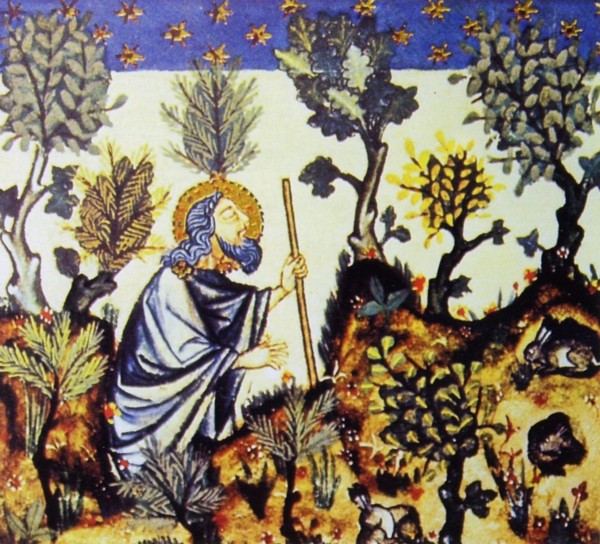
CANTIGAS DE BIZANCIO
Las Cantigas del Oriente Cristiano son canciones del siglo
XIII. Músicas hechas en los Reinos de Castilla, León y
Andalucía que cantan sucesos recogidos en el Oriente
conocido de la época. Constantinopla aparece como lugar
donde suceden 9 Cantigas, y en ellas se valora una visión
anti-iconoclasta con la narración y descripción de
valiosos, bellos y milagrosos iconos de Santa María. Un programa
inédito lleno de sutiles y exquisitas historias que muestran la
cercanía del Oriente y del otro extremo del mar
Mediterráneo en la Edad Media española.
Alfonso X tenía una importante ascendencia familiar europea.
Hijo de Fernando de Castilla y León y de Beatriz de Suabia,
sobrino de San Luis IX de Francia y del emperador Federico II, rey de
Sicilia y de la emperatriz Constanza, nieto de Felipe de Suabia y de
Alfonso IX de León, bisnieto del emperador Federico
Barbarroja y de Irene de Bizancio -hermana del emperador Alejo
IV, y también descendente de Leonor de Inglaterra, hermana
de Ricardo Corazón de León e hija de Enrique II
Plantagenet y Leonor de Aquitania, casó con Violante de
Aragón, hija de la reina Violante de Hungría y Jaime I de
Aragón. Tuvo también relaciones diplomáticas con
lugares distantes como el reino de Noruega, el sultán de Egipto
y el Khan de los Tártaros.
En la corte de Alfonso X el Sabio, 1253-1284, se confeccionaron los
Códices de las Cantigas en poesía galaico-portuguesa, uno
de los mayores frutos en la literatura de la época y la
colección de melodías más importante de la
Europa del siglo XIII.
CD 1
1 - CSM 9. EL ICONO DE DAMASCO
Milagro de Nuestra Señora de Sardonay (Sidnaya). Un peregrino
hacia Jerusalén recibe de una monja fundadora de un
hospital cerca de Damasco el encargo de adquirir un icono de la Virgen.
El monje lo olvida y una voz se lo recuerda. Compra el icono a buen
precio y quiere quedárselo para venderlo en su tierra. La imagen
le salva de un león, de unos salteadores y del naufragio del
barco, de camino a Francia, que le iba a llevar a Constantinopla para
dar el icono a la iglesia de su orden. La nave retorna a Acre y al
hospital donde no quiere entregar el icono encargado, y por ello
milagrosamente, no puede salir de la iglesia. El icono, colocado en su
altar definitivo, se hace de carne y mana un óleo milagroso
“leche de la Virgen”.
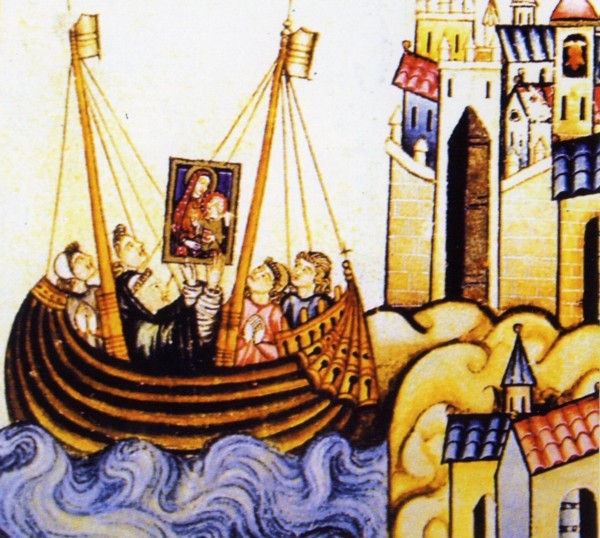 2 - CSM 34. EL ICONO PERDIDO
2 - CSM 34. EL ICONO PERDIDO
Un judío roba un icono precioso y bellísimo de Santa
María, lo esconde y mas tarde muere. Un cristiano recupera el
cuadro y lo limpia. La imagen huele a especias de Ultramar y al ponerla
en buen lugar, de ésta manó un óleo
milagroso.
3 - CSM 29. LA VIRGEN DE LA LECHE
Devoción de un mahometano en las guerras de cruzada de Ultramar
a María en un icono que vierte leche por ambos pechos. Este
caudillo sarraceno se convierte con los suyos ante el prodigio.
4 - CSM 264. VIRGEN BLACHERNIOTISSA
Santa María hace perecer las naves de los moros que
tenían cercada Constantinopla cuando los cristianos ponen la
imagen de la Virgen Blacherniotissa, que pintó San Lucas, en lo
alto de la ciudad.
5 - CSM 46. EL MORO DE ULTRAMAR Y LA VIRGEN DE LA LECHE
Un caudillo moro de Tierra Santa en Ultramar se quedó con un
icono de Santa María como parte del botín de la guerra
contra los cristianos. Meditando incrédulo sobre la
Encarnación de Dios en la Virgen, vio como la imagen
vertía leche por ambos pechos. Emocionado, se hizo bautizar
junto a los suyos.
6 - CSM 28. EL CERCO DE CONSTANTINOPLA
Santa María defendió la ciudad de Constantinopla del
sultán de Siria que la combatía y creía poder
tomarla. El patriarca San Germán implora a la Virgen que tiende
su manto protector sobre la ciudad. El sultán lo ve y se
presenta ante el patriarca para pedirle hacerse cristiano.
CD 2
1 - CSM 145. SAN JUAN ELIMOSYNARIUS
San Juan Elemosynarius, patriarca de Alejandría, (†620),
empobrecido hasta el extremo por haber dado todo a los pobres, invoca a
Santa María. Un pastorcillo celestial le entrega un inmenso
tesoro venido del cielo.
2 - CSM 265. SAN JUAN DAMASCENO
Santa María curó a San Juan Damasceno (Padre de la
iglesia griega, †780) la mano que le mandó cortar el emperador
León III, debido a unas falsas cartas que escribió un
alumno envidioso, imitando su letra. Cantiga grande de 27 estrofas.
3 - CSM 131. EL EMPERADOR Y EL PATRIARCA
Alejo I (1081-1118), emperador de Constantinopla, queda sepultado
cuando visita sus minas de plata. Gracias a las oraciones de la
emperatriz Jordana, Santa María alimenta al emperador. El
patriarca de Constantinopla después de un año tiene una
visión del hecho y se lo anuncia a la reina. Le salvan y todos
dan gracias a Santa María.
4 - CSM 25. EL JUDÍO DE BIZANCIO
Un judío de Bizancio presta dinero a un mercader cristiano y
pone por firma a Santa María y a su Hijo. Vencido el plazo manda
un arca por mar que milagrosamente llega al judío. Este la
guarda sin decir nada y cuando llega el mercader le exige la
devolución del préstamo. Acuden a la imagen de Santa
María, que habló en testimonio a favor del cristiano. El
judío admirado, se convierte.
5 - CSM 342. ICONO EN LA PIEDRA
En la época de Manuel I Komnenos (1143-1180), emperador de
Constantinopla, cuando mandó construir un templo con piedra de
mármol, al serrar la piedra apareció en las vetas el
dibujo de Santa María con el Niño, y lo pusieron en la
puerta.
6 - CSM 138. SAN JUAN CRISÓSTOMO
Leyenda hagiográfica de San Juan Crisóstomo, patriarca
que fue desterrado de Constantinopla. Le sacaron los ojos y abandonado
cayó por un barranco en un zarzal. La Virgen le salva y
éste le pide que le muestre lo que Cristo había amado
más en este mundo. Se le aparece la Virgen con el Niño al
pecho y recupera la vista y más tarde su dignidad y
posición.
Eduardo Paniagua
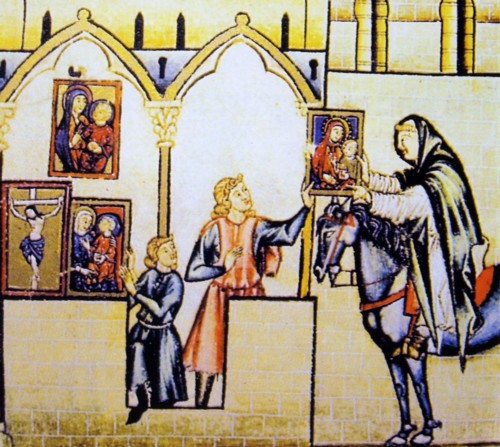
CANTIGAS OF BYZANTIUM
The Cantigas of the Christian Orient
are songs from the 13th century. Created in the kingdoms of Castile,
Leon and Andalusia they refer to events concerning the Orient known at
the time. 9 Cantigas took place in Constantinople. In these an
anti-iconoclastic vision can be appreciated with the narration and
description of valuable, beautiful and miraculous icons of the Virgin
Mary. A previously unreleased programme full of subtle and exquisite
stories that show the proximity of the Orient and of the other extreme
of the Mediterranean Sea in the Spanish Middle Ages.
Alfonso X
had important European ancestors. He was the son of Fernando of Castile
and Leon and of Beatriz of Swabia, nephew of both St. Louis IX of France
and of the Emperor Frederick II, king of Sicily and of the Empress
Constance, grandson of Philip of Swabia and of Alfonxo IX of Leon, great
grandson of the emperor Frederick Barbarossa (Redbeard) and of Irene of
Byzantium — sister of the emperor Alexios IV, and also a descendant of
Eleanor of England, sister of Richard the Lionheart and daughter of
Henry II Plantagenet and Eleanor of Aquitaine. He married Violant of
Aragon, daughter of Queen Violant of Hungary and James I of Aragon. He
also had diplomatic relations with distant places such as the kingdom of
Norway, the Sultan of Egypt and the Khan of the Tatars.
The
Codices of the Cantigas were completed in the court of Alfonso X the
Wise, between 1253-1284, written in Galician-Portuguese poetry. They
constitute one of the major fruits of the literature of the time and the
most important collection of melodies in 13th century Europe.
CD 1
1. CSM 9. THE ICON OF DAMASCUS
Miracle
of Our Lady of Sardonay (Sidnaya). A pilgrim on his way to Jerusalem
was asked to acquire an icon of the Virgin by a nun who ran a hospital
near Damascus. The monk forgets and a voice reminds him. He buys the
icon at a good price and wants to keep it to sell in his country. On his
journey to Constantinople to give the icon to the church of his order
the image saved him from a lion, from some highwaymen and from a
shipwreck on the way to France. The ship returns to Acre and to the
hospital where still he resists handing over the commissioned icon, and
miraculously cannot leave the church. The icon, on its definitive altar,
becomes flesh and a miraculous oil flows out "milk of the Virgin".
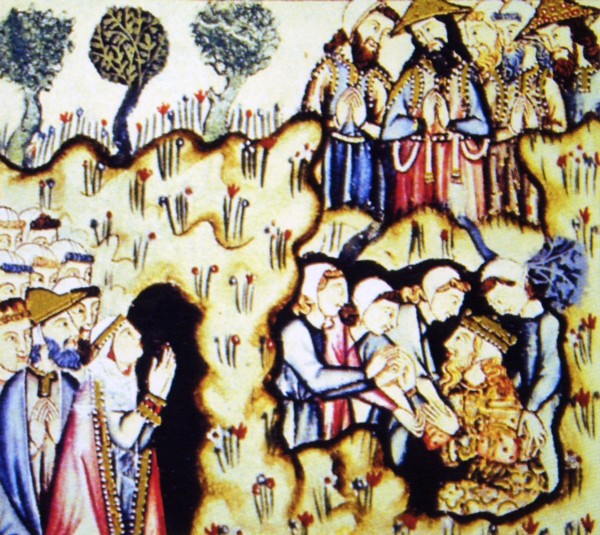 2. CSM 34. THE LOST ICON
2. CSM 34. THE LOST ICON
A
Jew steals a precious and beautiful icon of the Virgin Mary, hides it
and later dies. A Christian recovers the picture and cleans it. The
image smells of spices from overseas and when put in a safe place, a
miraculous substance like oil flows from it.
3. CSM 29. THE VIRGIN OF THE MILK
This
is the story of a Moor in the crusades overseas who was devoted to an
icon of Mary in which milk flows from both breasts. This Saracen leader
and his company are converted in the face of the miracle.
4. CSM 264. THE VIRGIN BLACHERNIOTISSA
The
Moorish ships that besieged Constantinople perished because of the
Virgin Mary, when the Christians placed the painting of the Virgin
Blacherniotissa by St. Luke, at the top of the city.
5. CSM 46. THE MOOR FROM OVERSEAS AND THE VIRGIN OF THE MILK
A
Moorish leader from the Holy Land kept an icon of Holy Mary as part of
the loot from the war against the Christians. Whilst meditating in
disbelief on the Incarnation of God in the Virgin, he saw how milk
flowed from both breasts. In his excitement he became baptised along
with many other Moors.
6. CSM 28. THE SIEGE OF CONSTANTINOPLE
The
Virgin Mary defended the city of Constantinople from the sultan of
Syria who was fighting for it and thought he could take it. The
patriarch St. Germanos appealed to the Virgin for help and She spread
her protective cloak over the city. The sultan witnessed the miracle and
approached the patriarch to ask him to make him a Christian.
CD 2
1. CSM 145. ST. JOHN ELEEMOSYNARIUS
St.
John Eleemosynarius, patriarch of Alexandria, (+620), impoverished in
the extreme having given everything away to the poor, appealed to the
Virgin Mary. A celestial shepherd gives him an immense treasure from
heaven.
2. CSM 265. ST. JOHN THE DAMASCENE
The Virgin Mary
healed the hand of St. John the Damascene (Father of the Greek church,
+780), which the Emperor Leon III had ordered be cut off, because of the
false letters that a jealous pupil wrote imitating his writing. Cantiga
"grande" of 27 stanzas.
3. CSM 131. THE EMPEROR AND THE PATRIARCH
Alexios
1(1081-1118), Emperor of Constantinople, was buried while visiting his
silver mines. Thanks to the prayers of the Empress Jordana, the Virgin
Mary provided the Emperor with food. A year later the patriarch of
Constantinople had a vision of what happened and he told the queen. The
Emperor was saved and they all gave thanks to the Virgin Mary.
4. CSM 25. THE JEW FROM BYZANTIUM
A
Jew from Byzantium lent money to a Christian merchant who used the
Virgin Mary and Her son as guarantors. When the debt fell due the
Christian sent the money by sea in a chest that miraculously reached
the
Jew who put it away without saying anything. He then demanded the
return of the loan when the merchant arrived. They turn to the image of
the Virgin Mary, who spoke in favour of the Christian. The Jew, in
wonder, was converted.
5. CSM 342. THE ICON IN THE STONE
The
Emperor of Constantinople Manuel I Komnenos (1143-1180), commissioned
the building of a marble temple. The image of Holy Mary and the Child
appeared in the rock when it was cut and it was used for the door.
6. CSM 138. ST. JOHN CHRYSOSTOM
A
hagiographic legend of St. John Chrysostom, the patriarch who was
banished from Constantinople. His eyes were gouged out and he was left
to die. He fell off a precipice into a bramble patch. The Virgin saved
him and he asked Her to show him what Christ had loved most in this
world. The Virgin with Child at the breast appeared before him and he
recovered his sight and later his honour and position.
EDUARDO PANIAGUA
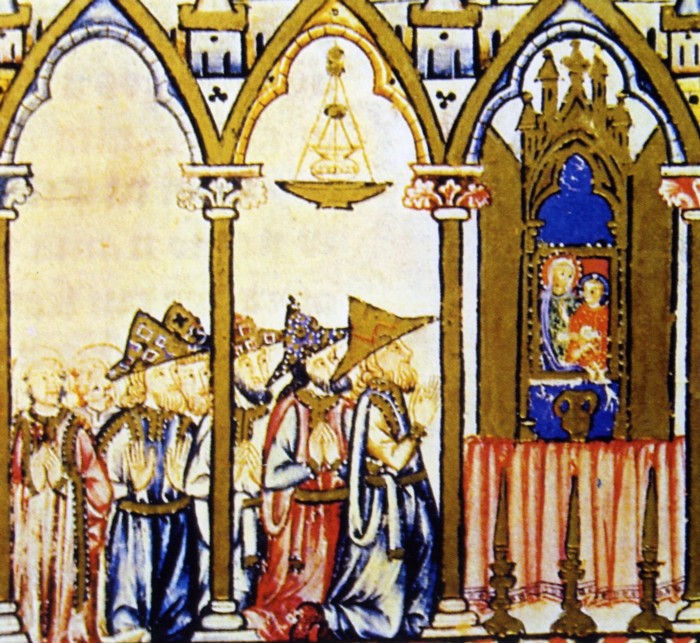



 2 - CSM 34.
2 - CSM 34. 
 2. CSM 34.
2. CSM 34. 